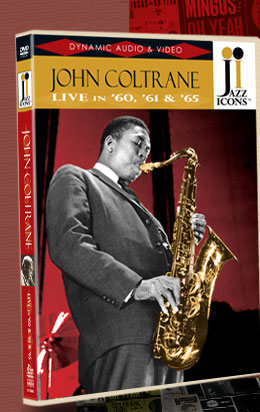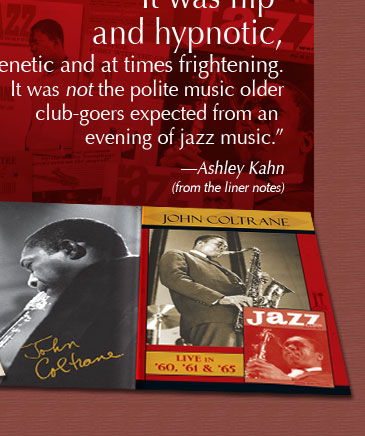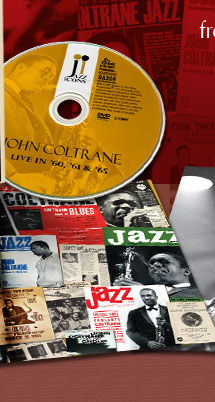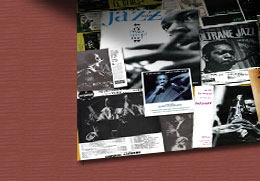




 |
 |
|
|||
|
|
|
||||
|
|
|
||||
|
|
|
||||
|
|
|
||||
 |
|
||||
 |
|
||||
 |
|
||||
|
|
|
|
|
|
|
Jazz Icons: John Coltrane provides an epic 95-minute overview of a true giant of 20th-century music. Three separate shows reveal Coltrane's ascending creative arc from hard bop innovator as a member of the Miles Davis Quartet in 1960 to consummate bandleader in 1961 to unrivalled jazz visionary in 1965. This DVD not only features Trane's classic quartet with Elvin Jones (drums), Jimmy Garrison (bass) and McCoy Tyner (piano), but also spotlights him onstage with other jazz legends including Stan Getz, Eric Dolphy and Oscar Peterson. Includes mind-blowing versions of his signature tunes "My Favorite Things" and "Impressions". |
|
 |
|
|
John Coltrane (Tenor & Soprano Sax) Wynton Kelly (Piano) Paul Chambers (Bass) Jimmy Cobb (Drums) with guests Oscar Peterson (Piano) Stan Getz (Tenor Sax) |
|
 |
|
|
John Coltrane (Tenor & Soprano Sax) Eric Dolphy (Alto Sax & Flute) McCoy Tyner (Piano) Reggie Workman (Bass) Elvin Jones (Drums) |
|
 |
|
|
John Coltrane (Tenor & Soprano Sax) McCoy Tyner (Piano) Jimmy Garrison (Bass) Elvin Jones (Drums) |
|
|
|
|
|
Foreword: It’s hard to imagine that John Coltrane’s recording career lasted only 12 years. His was an unending intellectual and spiritual quest through music. No one with such an extraordinary degree of talent worked as hard to master his instrument and to seek the deepest form of human expression through it. In that 12 years, Coltrane was always instantly identifiable, yet always changing and evolving. The three performances on this DVD show in dramatic relief the most important phases of his career. These newly discovered 1960 performances with Miles Davis’s rhythm section find him near the end of his “sheets-of-sound” period, which gave us such masterpieces as “Mr. P.C.” and “Giant Steps.” Coltrane was anxious to form his own group and this final tour with Davis was a favor to the trumpeter. His restlessness shows through in his playing here and elsewhere at the time. It is fascinating to hear him with one of his early idols Stan Getz and his playing seems to challenge Getz to a new level. ... The 1965 Comblain-La-Tour performance, providing some great visuals, allows us to see the group at the peak of its powers and near the end of its run. By the end of the year, McCoy and Elvin were gone and one of the most innovative and exciting ensembles in jazz was no more. —Michael Cuscuna
Sample Liner Notes by Ashley Kahn: Of all the giants of modern jazz—and by giant I mean those whose shadows still loom large over today’s music scene —none seem as woefully under-represented in the medium of moving image as John Coltrane. It almost seems as if he had an aversion to film and television cameras. How else to explain the number of taped performances that doesn’t even reach a dozen? It’s a little difficult to be precise. There might be more visual recordings of Coltrane, just waiting to be discovered in some government archive or personal collection. There have been rumors of a film of Dizzy Gillespie’s big band in 1950 with Coltrane in the horn section, as well as an Italian concert from 1962. And there’s the first half hour of this DVD—a long-buried German TV broadcast from 1960 that is now available commercially for the first time. Small surprise that the state-owned media libraries of Europe have yielded most of what exists of Coltrane in action. Reverence for progressive jazz – especially the more challenging style that Coltrane helped pioneer—has always seemed to first flower overseas. And adulation for Coltrane specifically? In Europe, it was ever more immediate, and largely free of the controversies that dogged him back home as he continually changed sound and style from 1957, when he recorded his first album as a leader, until his passing in 1967. Having the chance to mark that progress, to see as well as hear a few moments along that creative timeline, is one of the delights of this DVD. The shifts are marked and measurable; the Coltrane of 1960, approaching the end of more than four years as a sideman in Miles Davis’s lineup, was not the Coltrane of 1961, a bandleader of confidence and growing success. By 1965, Coltrane’s groundbreaking quartet had been running with near-telepathic unison for almost four years, pushing their music to dramatic and dizzying heights—sparking what many hail as the last significant leap forward in modern jazz. Coltrane’s continuing importance in the realm of jazz is reason enough for this DVD. But his influence reaches a far wider musical circle that looks beyond categories, one that stays hungry for any evidence of such musical titans in action. For all the above, the three performances herein capture Coltrane’s defining elements: his brittle and blues-drenched tone, his vocal-like vocabulary of slurs, shrieks and rapid-fire runs, his deep sense of searching and spirituality—channeling both a lilting, Eastern mysticism and a down-home, Pentecostal fury. ... March 28, 1960 – Düsseldorf, West Germany For Coltrane, it was his first time overseas, and yet the trip held little charm. He had already exited the trumpeter’s band when he reluctantly agreed to remain with the group that had lifted him from obscurity in late ’55. Doing so required that he put his plans for starting his own band on hold. “He grumbled and complained and sat by himself all the time we were over there,” Davis recalled years later. Coltrane’s behavior was atypical for the normally even-keeled saxophonist, but then he did have to cancel a series of dates at New York’s Five Spot nightclub. And that wasn’t the only bit of drama involving Davis. When the tour arrived in Düsseldorf at the end of its first week, Granz was told that Davis would not be participating in an already scheduled television taping. ... August 1, 1965 – Comblain-La-Tour, Belgium It was about much more than just the length, it was what the quartet delivered in extended doses: sustained, elevating energy and a marked density of musical ideas, a heightened sense of drama, and a sweat-inducing delivery that seemed to somehow articulate answers to spiritual mysteries. It was hip and hypnotic, frenetic and at times frightening. It was not the polite music older club-goers expected from an evening of jazz entertainment. No wonder Coltrane’s circle of listeners was ever widening. He was attracting a younger generation that had learned to demand more and more from their music. Like many of them, Coltrane’s personal spirituality – sparked by an intense curiosity that balanced Western and Eastern religious thought – was influencing his music more and more directly. His album A Love Supreme, with the sound and effect of a four-part Sunday morning service, was released in January 1965 and proved to be his best-selling album to date. But Coltrane’s worldview was not limited to Sunday mornings or Christian ritual. His philosophy was all-inclusive and universal, and he saw his music as one activity among many, one part of a life-consuming drive to turn thought and positive intention into an influential sound. “Once you become aware of this force for unity in life, you can’t ever forget it. It becomes part of everything you do,” Coltrane said in 1965. “My goal of meditating on this through music, however remains the same. And that is to uplift people, as much as I can. To inspire them to realize more and more of their capacities for living meaningful lives…” A Love Supreme had yet to be released in Europe when Coltrane arrived in Paris for a brief four-date tour in France and Belgium. Granz was not involved this time around. The saxophonist had been booked directly through his agent to play two nights at the International Jazz Festival in Antibes, then the prestigious Salle Pleyel in Paris, and finally, an outdoor jazz festival in a small town just south of Liege, Belgium: Comblain-La-Tour. In fact, three of the four dates took place al fresco, and unseasonably cool weather seemed determined to follow the quartet. “It was a little chilly at that time—real nippy,” recalls Tyner of their opening night on the Mediterranean coast. Four days later in Belgium, it was much the same, as the crowd shots, showing spectators in coats and hats, attest. Onstage, the TV cameras caught the clouds of condensation created by the players’ body heat, rising like smoke into the cold evening air. ... All words and artwork on this page ©Reelin' In The Years Productions. Unauthorized use is prohibited.
|
|
Site contents ©Copyright 2007 Reelin' In The Years Productions
Site designed by Tom Gulotta